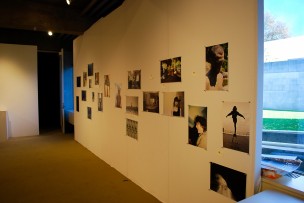Through email, artists produce engaging works.
Thanks to the Internet, communication and conversation have been expedited to the point where it takes less than a second for someone to receive a message sent from halfway across the world. Artistic collaboration has developed and changed as a result of the technological revolution.
It is this notion of utilizing the Internet to produce art that drew Sophia Jennings ’16 to the Exquisite Corpse Project, which went up in the Zilkha Gallery this past weekend.
This summer in New York City, Jennings and her best friend from high school, KT Lee (Columbia University ’16), came across the idea of curating an art show based on online collaboration. Lee approached Jennings with a game she had been playing with the show’s third curator, Joe Bucciero (CU ’15).
The game, which was created by surrealist artists in the 1920s, entails drawing exquisite corpses: that is, drawing an image on a piece of paper, folding that paper over, and having someone else add to the image without knowing what was drawn before. Thus, the groundwork was laid for the premise of the Exquisite Corpse Project.
The Exquisite Corpse Project, which was first presented at Columbia University earlier in October, grew into a curated art show displaying works made by students at both Wesleyan and Columbia. However, these were not collaborations in the traditional sense, with both artists working side-by-side. Rather, they took on an Internet-age twist: the artists could only communicate via email.
“I thought [the show] could serve as a study of how we interact with art, that being music, video, literature, photography, drawing, et cetera, over the Internet,” Jennings wrote in an email to the Argus.
Jennings described that the show explores the contemporary artistic process wherein someone in Toronto could put a song up on SoundCloud and another person in Dubai could download it, remix it, and eventually re-upload an entirely new track, still based off the original piece made in Toronto.
Jennings and Lee have been using the Web as a tool for channeling creativity since high school. They would ruminate over ideas for their high school arts magazine via Skype, Facebook, or iChat on school breaks when Jennings was in San Francisco and Lee was in Seoul.
The global reach of the Web is exemplified by the geographical backgrounds of the artists included in the Exquisite Corpse show. Students from Geneva, London, Caracas, and even Shaker Heights, Ohio, are all represented.
What’s more, “Exquisite Corpse” delves into the Internet’s inclination towards anonymity. In assembling the show, the artists from the two schools had no prior knowledge of their partners or their partners’ prior works. Never meeting, and only communicating through the terse, fragmentary medium of email, the artists only shared slivers of their work with each other.
Such a process rattled the control each individual artist had over hir work as a whole, since they weren’t afforded the opportunity to see what their partners were creating. This, again, underscores a major shift caused by the Internet, in which artists lose some or all control over what they place online; once a work is there, anyone can take control of it and distort it however they want.
“It’s not like I had enough to go on by the one-inch strip to know what Jesy [her collaborator)]was trying to get at,” Amy Zhang ’15, one of the “Exquisite Corpse” artists, wrote in an email to the Argus.
The show made use of almost every medium an artist could work in, including written words, film, photography, drawing, and painting. Entering the Zilkha Gallery, one is welcomed by a showcase of photographs by Method Magazine’s photography staff on the right and the “Exquisite Corpse” collaborative visual pieces on the left. Straight ahead against the back wall are five podiums with various written works resting upon them. Beyond this wall, the show’s video art is projected on a screen.
The work of Canada Choate (CU ’18) and Elijah Stevens ’15 combines photography, drawing and written word. They broke the work vertically into four separate parts: The top sector incorporates a photograph tilted 90 degrees in the center, with avant-garde poems written on either side. The second section makes use of strict lines creating geometric shapes, which are symmetrical and emerge from the bottom of the photograph in the top portion.
The third section again reverts to photography, mimicking the overall triangular shape of the drawing above it. Two hands emerge at either side of this section; to whom they belong is unclear. A person stands between the hands at a distance, with only the bottom part of a torso, shorts, and knees visible. The final portion of the work again makes use of pencil, geometric, non-formal drawings. At the top right corner, a pattern of brick continues from the photo above it.
Most of the works in the show mirror this disjointed, fragmentary collection of style, medium, and formal features, the whole point of “Exquisite Corpse.” Because of its variety, the show excites every sense. The viewer is engaged simply by being in the space, surrounded by clashing color schemes, written words that don’t combine to make a sentence, and the buzzing of the video beyond the wall.
Despite the seemingly cacophonous sensory experience of the show, a harmony does emerge from all the disparate works in their adherence to the show’s theme, the Internet’s effect on art production.
Jennings wrote that she feared biting off more than she could chew by curating a show with so many artists. But that ambition, no doubt, lead more than a few exquisite corpses.
